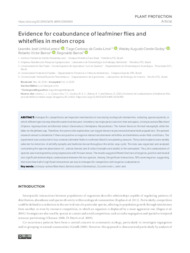Evidence for coabundance of leafminer flies and whiteflies in melon crops.
Evidence for coabundance of leafminer flies and whiteflies in melon crops.
Author(s): LEMOS, L. J. U.; COSTA-LIMA, T. C. da; GODOY, W. A. C.; BARROS, R. V.; BARROS, R.
Summary: Interspecific competitions are important mechanisms in structuring ecological communities, including agroecosystems, in which different species may share the same food resource. In melons, two major pests coexist in time and space, Liriomyza sativae Blanchard (Diptera: Agromyzidae) and Bemisia tabaci (Gennadius) (Hemiptera: Aleyrodidae). The former feeds on the leaf mesophyll, while the latter on the phloem sap. Therefore, the same niche exploitation can trigger interactive processes between both populations. The present research aimed to determine if there are positive or negative interactions between whiteflies and leafminers under field conditions. The experiment was conducted in four commercial melon fields in northeast Brazil in two planting seasons. Thirty random plants were weekly selected for detection of whitefly nymphs and leafminer larvae throughout the entire crop cycle. The data was organized and analyzed considering the species abundance of L. sativae (larvae) and B. tabaci (nymphs and adults) in the same plant. Thus, the coabundance of species was investigated by using regressions with Poisson errors. The results suggest different fractions of negative, positive and neutral (not significant relationships) coabundance between the two species. Among 34 significant interactions, 56% were negative, suggesting that more than half of significant interactions are due to interspecific competition with negative coabundance.
Publication year: 2021
Types of publication: Journal article
Unit: Embrapa Semi-arid Region
Observation
Some of Embrapa's publications are published as ePub files. To read them, use or download one of the following free software options to your computer or mobile device. Android: Google Play Books; IOS: iBooks; Windows and Linux: Calibre.
Access other publications
Access the Agricultural Research Database (BDPA) to consult Embrapa's full library collection and records.
Visit Embrapa Bookstore to purchase books and other publications sold by Embrapa.

